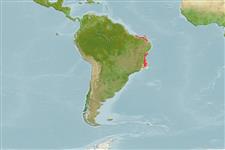Common names from other countries
Classification / Names / Names
Populärnamn | synonymer | Catalog of Fishes (gen., sp.) | ITIS | CoL | WoRMS
Environment: milieu / climate zone / depth range / distribution range
Ekologi
; djupintervall 0 - 30 m (Ref. 848). Tropical; 1°S - 25°S, 45°W - 37°W (Ref. 848)
Southwest Atlantic: Tamandare and Abrolhos Islands, Brazil.
Length at first maturity / Size / Vikt / Age
Maturity: Lm ? range ? - ? cm
Formation: with tubular corallites, often over 1 m across. Individual or small group of corallites usually not connected, i.e., have dead basal connections, and are easily broken and scattered. Corallites: rounded, in varied shapes averaging 15 to 20 mm diameter. Septa: rounded, bead-like dentations only in living colonies. Color: mostly bluish-gray (Ref. 848).
Occurs in shallow turbid reef environments (Ref. 848).
Life cycle and mating behavior
Könsmognad | Reproduktion | Lek | Ägg | Fecundity | Larver
Members of the class Anthozoa are either gonochoric or hermaphroditic. Mature gametes are shed into the coelenteron and spawned through the mouth. Life cycle: The zygote develops into a planktonic planula larva. Metamorphosis begins with early morphogenesis of tentacles, septa and pharynx before larval settlement on the aboral end.
Veron, J.E.N. 2000. (Ref. 848)
IUCN Red List Status (Ref. 130435)
CITES status (Ref. 108899)
Not Evaluated
Human uses
| FishSource |
Verktyg
Ytterligare information
Age/SizeTillväxtLength-weightLength-lengthMorfologiLarverAbundans
Internet-källor
Estimates based on models
Preferred temperature
(Ref.
115969): 25.9 - 27.6, mean 27 (based on 87 cells).
Price category
Unknown.
